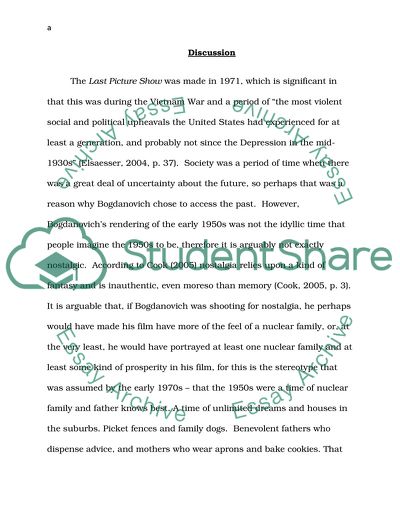Cite this document
(The Appearance of Nostalgia for American Cinemas History in the Films Research Paper, n.d.)
The Appearance of Nostalgia for American Cinemas History in the Films Research Paper. Retrieved from https://studentshare.org/visual-arts-film-studies/1751124-to-what-extent-is-it-possible-to-argue-for-the-appearance-of-nostalgia-for-american-cinemas-history-in-the-films-of-the-1970s-account-for-this-phenomenon-with-reference-to-two-or-more-salient-examples
The Appearance of Nostalgia for American Cinemas History in the Films Research Paper. Retrieved from https://studentshare.org/visual-arts-film-studies/1751124-to-what-extent-is-it-possible-to-argue-for-the-appearance-of-nostalgia-for-american-cinemas-history-in-the-films-of-the-1970s-account-for-this-phenomenon-with-reference-to-two-or-more-salient-examples
(The Appearance of Nostalgia for American Cinemas History in the Films Research Paper)
The Appearance of Nostalgia for American Cinemas History in the Films Research Paper. https://studentshare.org/visual-arts-film-studies/1751124-to-what-extent-is-it-possible-to-argue-for-the-appearance-of-nostalgia-for-american-cinemas-history-in-the-films-of-the-1970s-account-for-this-phenomenon-with-reference-to-two-or-more-salient-examples.
The Appearance of Nostalgia for American Cinemas History in the Films Research Paper. https://studentshare.org/visual-arts-film-studies/1751124-to-what-extent-is-it-possible-to-argue-for-the-appearance-of-nostalgia-for-american-cinemas-history-in-the-films-of-the-1970s-account-for-this-phenomenon-with-reference-to-two-or-more-salient-examples.
“The Appearance of Nostalgia for American Cinemas History in the Films Research Paper”, n.d. https://studentshare.org/visual-arts-film-studies/1751124-to-what-extent-is-it-possible-to-argue-for-the-appearance-of-nostalgia-for-american-cinemas-history-in-the-films-of-the-1970s-account-for-this-phenomenon-with-reference-to-two-or-more-salient-examples.


